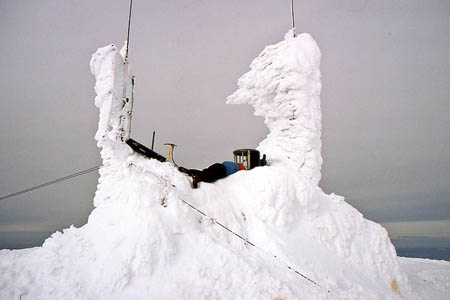
The weather station on Cairn Gorm, where a gust of 165mph was recorded. Photo: Jim Barton CC-BY-SA-2.0
Mountains in the Scottish Highlands are at high risk of avalanche as near-record winds batter the country.
The sportscotland Avalanche Information Service starts in full on 15 December, but two areas are covered by early reports and forecasts.
The northern Cairngorms, where a 165mph (265kph) gust was recorded today, have a high avalanche risk – meaning natural and human-triggered avalanches will occur – on aspects from north-east to south.
A report from its assessors says accumulations of unstable windslab will continue to form above 800m where avalanches will occur. Unstable deposits of windslab will be present in many other locations.
Eastern through to south-western aspects in Lochaber are at considerable risk, one level lower, again on slopes above 800m. Fresh cornices are prone to collapse, SAIS said.
In Lochaber, the town of Fort William is virtually cut off, with outdoors writer Vivienne Crow reporting via Twitter that there are no buses or trains leaving the town.
Mountain guide Alan Kimber said the weather was ‘dreadful’. On his site, he said: “Fort William is currently cut off from the outside world due to hurricanes, landslides and fallen trees.”
However, he reports: ‘loads of snow on the hills though, which has got a good soaking and when it freezes conditions should be quite good’.
Northern Constabulary, which declared a major incident in the wake of the storm, said recently: “The A82 is currently closed at the Corran Ferry, south of Fort William due to a landslide.
“This situation will be monitored and there are no diversions in place.
“The A890 is closed at Strome Ferry due to a rockfall. This situation is due to be assessed during the morning of Friday 9 December. There are no diversions available.
“The A87 at Sheilbridge is currently closed due to a land slide. Local diversions are in place.”
The Skye Bridge was also closed due to high winds.
The Lake District’s felltop assessor, who normally makes the daily climb to the top of England’s third highest mountain, had to turn back today due to high winds – the second time since the start of the service earlier this month.
The assessor measured a gust of 72mph in a sheltered area on his way up Helvellyn
The Weatherline service, operated by the Lake District National Park Authority, said full winter clothing and footwear are essential for anyone venturing out on to the fells. “For those going above the snow-line and attempting or traversing steep routes, an ice-axe is strongly recommended and crampons should be carried in case the snow freezes, which it is forecast to do,” the assessor added.
He also made a plea to winter climbers not to tackle routes yet. “To avoid damage to fragile and nationally important habitats, winter climbers are advised to wait until climbing routes are in full winter condition before attempting the gully routes,” he said.
“Please avoid the temptation to climb in gullies while there is still chance of damaging the vegetation cover.”